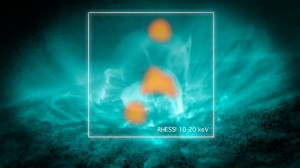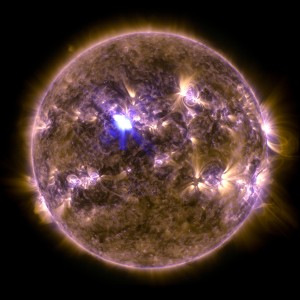
An overlap of data from two NASA spacecraft confirm a sighting of magnetic reconnection on the sun. The teal image, from SDO, shows the shape of magnetic field lines in the sun’s atmosphere, the RHESSI data, in orange. (NASA/SDO/RHESSI/Goddard)
Over the past several years, NASA spacecraft studying the sun have sent back some spectacular images of it exploding with solar flares and coronal mass ejections. Now, scientists say that two of these spacecraft — the Solar Dynamics Observatory (SDO) and the Reuven Ramaty High Energy Solar Spectroscopic Imager (RHESSI) — have detected a phenomenon called magnetic reconnection, what they describe as the ‘Heart of Space Weather’ in action.
NASA describes magnetic reconnection as something that takes place whenever the sun’s magnetic field lines first unite, arch out, break apart, reconnect with different magnetic fields, then snap into new positions, releasing a pulse of magnetic energy along the way. Scientists believe that the magnetic reconnection process is what’s behind enormous explosions on the sun that can hurl radiation and various energy related particles across the entire solar system.
If they could get a better understanding of this process, the scientists say, they may be able to develop new methods that would allow for much more advanced and detailed warnings on upcoming space weather events. These events, like the solar flares and coronal mass ejections, or CMEs, can wreak havoc with orbiting satellites, radio communications and even the world’s power grids.

NASA’s Solar Dynamics Observatory captured this image of an M6.5 class flare. This image shows a combination of light in wavelengths of 131 and 171 Angstroms – light wavelength measurement.- (NASA/SDO)
One reason why it’s so hard to study magnetic reconnection is that it can’t be witnessed directly because magnetic fields are invisible. Instead, scientists have been using a combination of computer modeling and a scant sampling of observations around magnetic reconnection events to try to understand what’s going on.
“The community is still trying to understand how magnetic reconnection causes flares,” said Yang Su, a solar scientist at the University of Graz in Austria. “We have so many pieces of evidence, but the picture is not yet complete.”
Su found some new visual proof of this phenomenon as he was pouring through observations that had been made by the SDO spacecraft. It was something that would have been very difficult to find by using SDO data alone; the scientist actually found some direct images of magnetic reconnection itself taking place on the sun.
What the scientist saw was were two bundles of the magnetic field lines shift near each other, which then meet briefly to form what seemed to be an “X,” and then blast apart from each other with one group of lines leaping into space and while another set fell back down into the sun.
Now, since the magnetic fields themselves are invisible, they can be seen by space telescopes as bright lines that loop and arc throughout the sun’s atmosphere. These visible bright line lines are actually the magnetic fields lined with plasma — material made up of force charged particles that make up much of the sun — that pulse up and along the length of the fields.

When magnetic fields lines on the sun come together they can realign into a new configuration. The process, called magnetic reconnection, can produce tremendous amounts of energy, powering gigantic explosions in the sun’s atmosphere. (NASA Goddard)
“It can often be hard to tell what’s truly happening in three dimensions from these images, since the pictures themselves are two-dimensional,” said Gordon Holman, a solar scientist at NASA’s Goddard Space Flight Center in Greenbelt, Maryland. “But if you look long enough and compare data from other instruments, you can make a good case for what’s going on.”
To get conformation of what the scientists were actually seeing, they went to a second spacecraft that’s keeping an eye on the sun, the Reuven Ramaty High Energy Solar Spectroscopic Imager, or RHESSI. This spacecraft gathers data to form spectrograms that can show researchers where extremely hot material may be present during various solar events.
In confirming the images scientists gathered from the SDO, the spectrograms produced by the RHESSI showed that there were hot pockets of solar material forming both above and beneath magnetic reconnection points, which provided the scientists with an established signature of the reconnection event.
Combining the images and data from both the SDO and RHESSI, scientists were then able to describe what they were actually seeing. Putting together the studies with information from both spacecraft allowed the scientists to confirm many previous models and theories. And at the same time, they were able to provide some new, three-dimensional aspects of the magnetic reconnection process.
The research and findings were outlined in the July 14th edition of the journal Nature Physics.
NASA video explains what the SDO and RHESSI spacecraft captured





















I cannot deny that there are facilities that have been built and eventually discovered on the Lunar and Mars land bases.
The evidence is still not available, yet. I hope to live long enough to see all this come to fruation.